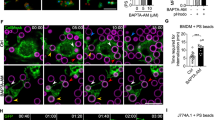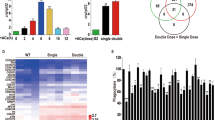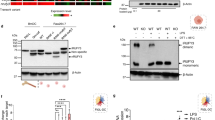Abstract
Integrin receptors are important for the phagocytosis of apoptotic cells. However, little is known about their function in mediating internalization, as previous studies used blocking antibodies for the inhibition of binding. Here we show that the αvβ5 receptor mediates both binding and internalization of apoptotic cells. Internalization is dependent upon signalling through the β5 cytoplasmic tail, and engagement of the αvβ5 heterodimer results in recruitment of the p130cas–CrkII–Dock180 molecular complex, which in turn triggers Rac1 activation and phagosome formation. In addition to defining integrin-receptor signalling as critical for the internalization of apoptotic material, our results also constitute the first evidence in human cells that the CED-2–CED-5–CED-10 complex defined in Caenorhabditis elegans is functionally analagous to the CrkII–Dock180–Rac1 molecular complex in mammalian cells. By linking the αvβ5 receptor to this molecular switch, we reveal an evolutionarily conserved signalling pathway that is responsible for the recognition and internalization of apoptotic cells by both professional and non-professional phagocytes.
This is a preview of subscription content, access via your institution
Access options
Subscribe to this journal
Receive 12 print issues and online access
$209.00 per year
only $17.42 per issue
Buy this article
- Purchase on Springer Link
- Instant access to full article PDF
Prices may be subject to local taxes which are calculated during checkout






Similar content being viewed by others
References
Savill, J. Apoptosis: phagocytic docking without shocking. Nature 392, 442–443 (1998).
Platt, N., da Silva, R. P. & Gordon, S. Recognizing death: the phagocytosis of apoptotic cells . Trends Cell Biol. 8, 365– 372 (1998).
Fadok, V. A. et al. A receptor for phosphatidylserine-specific clearance of apoptotic cells. Nature 405, 85–90 (2000).
Albert, M. L., Sauter, B. & Bhardwaj, N. Dendritic cells acquire antigen from apoptotic cells and induce class I- restricted CTLs. Nature 392, 86–89 (1998).
Inaba, K. et al. Efficient presentation of phagocytosed cellular fragments on the major histocompatibility complex class II products of dendritic cells . J. Exp. Med. 188, 2163– 2173 (1998).
Albert, M. L. & Bhardwaj, N. Resurrecting the Dead: DCs cross-present antigen derived from apoptotic cells on MHC I. The Immunologist 6, 194–199 (1998).
Albert, M. L. et al. Immature dendritic cells phagocytose apoptotic cells via α vβ5 and CD36, and cross-present antigens to cytotoxic T lymphocytes. J. Exp. Med. 188, 1359– 1368 (1998).
Kondo, K., Watanabe, T., Sasaki, H., Uehara, Y. & Oishi, M. Induction of in vitro differentiation of mouse embryonal carcinoma (F9) and erythroleukemia (MEL) cells by herbimycin A, an inhibitor of protein phosphorylation. J. Cell Biol. 109, 285–293 (1989).
Hsu, C. Y. et al. Kinetic analysis of the inhibition of the epidermal growth factor receptor tyrosine kinase by Lavendustin-A and its analogue. J. Biol. Chem. 266, 21105–21112 (1991).
Hughes, J., Liu, Y., Van Damme, J. & Savill, J. Human glomerular mesangial cell phagocytosis of apoptotic neutrophils: mediation by a novel CD36-independent vitronectin receptor/ thrombospondin recognition mechanism that is uncoupled from chemokine secretion. J. Immunol. 158, 4389–4397 (1997).
McLean, J. W., Vestal, D. J., Cheresh, D. A. & Bodary, S. C. cDNA sequence of the human integrin beta 5 subunit. J. Biol. Chem. 265, 17126–17131 (1990).
Petch, L. A., Bockholt, S. M., Bouton, A., Parsons, J. T. & Burridge, K. Adhesion-induced tyrosine phosphorylation of the p130 src substrate. J. Cell Sci. 108, 1371–1379 (1995).
Birge, R. B., Fajardo, J. E., Mayer, B. J. & Hanafusa, H. Tyrosine-phosphorylated epidermal growth factor receptor and cellular p130 provide high affinity binding substrates to analyze Crk-phosphotyrosine-dependent interactions in vitro. J. Biol. Chem. 267, 10588–10595 (1992).
Klemke, R. L. et al. CAS/Crk coupling serves as a `molecular switch' for induction of cell migration. J. Cell Biol. 140, 961 –972 (1998).
Kirsch, K. H., Georgescu, M. M., Ishimaru, S. & Hanafusa, H. CMS: an adapter molecule involved in cytoskeletal rearrangements. Proc. Natl Acad. Sci. USA 96, 6211– 6216 (1999).
Birge, R. B., Knudsen, B. S., Besser, D. & Hanafusa, H. SH2 and SH3-containing adaptor proteins: redundant or independent mediators of intracellular signal transduction. Genes Cells 1 , 595–613 (1996).
Steinkamp, J. A., Wilson, J. S., Saunders, G. C. & Stewart, C. C. Phagocytosis: flow cytometric quantitation with fluorescent microspheres. Science 215, 64– 66 (1982).
Sander, E. E. et al. Matrix-dependent Tiam1/Rac signaling in epithelial cells promotes either cell–cell adhesion or cell migration and is regulated by phosphatidylinositol 3-kinase. J. Cell Biol. 143, 1385– 1398 (1998).
Genot, E., Cleverley, S., Henning, S. & Cantrell, D. Multiple p21ras effector pathways regulate nuclear factor of activated T cells . EMBO J. 15, 3923–3933 (1996).
Reddien, P. W. & Horvitz, H. R. Ced-2/CrkII and Ced-10/Rac control phagocytosis and cell migration in Caenorhabditis elegans. Nature Cell Biol. 2, 131– 136 (2000).
Nolan, K. M. et al. Myoblast city, the Drosophila homolog of DOCK180/CED-5, is required in a Rac signaling pathway utilized for multiple developmental processes. Genes Dev. 12, 3337– 3342 (1998).
Kiyokawa, E. et al. Activation of Rac1 by a Crk SH3-binding protein, DOCK180. Genes Dev. 12, 3331–3336 (1998).
Kiyokawa, E., Hashimoto, Y., Kurata, T., Sugimura, H. & Matsuda, M. Evidence that DOCK180 up-regulates signals from the CrkII–p130(Cas) complex. J. Biol. Chem. 273, 24479–24484 ( 1998).
Hasegawa, H. et al. DOCK180, a major CRK-binding protein, alters cell morphology upon translocation to the cell membrane. Mol. Cell. Biol. 16, 1770–1776 (1996).
Erickson, M. R., Galletta, B. J. & Abmayr, S. M. Drosophila myoblast city encodes a conserved protein that is essential for myoblast fusion, dorsal closure, and cytoskeletal organization. J. Cell Biol. 138, 589–603 (1997).
Paululat, A., Holz, A. & Renkawitz-Pohl, R. Essential genes for myoblast fusion in Drosophila embryogenesis. Mech. Dev. 83, 17– 26 (1999).
Bhardwaj, N. et al. Influenza virus-infected dendritic cells stimulate strong proliferative and cytolytic responses from human CD8+ T cells . J. Clin. Invest. 94, 797– 807 (1994).
Bender, A., Sapp, M., Schuler, G., Steinman, R.M. & Bhardwaj, N. Improved methods for the generation of dendritic cells from nonproliferating progenitors in human blood. J. Immunol. Methods 196, 121–135 (1996).
Acknowledgements
We thank A. Rodriguez for assistance with the IF studies, S. Amigorena, N. Bhardwaj, R. B. Darnell, E. Fajardo and N. Hacohen for helpful discussions and critical comments, D. Cheresh for the αv and β5 gene constructs, R. M. Steinman and M. Nussenzweig for use of the FACScan, T. de Lange for use of the microscope, and M. Genova for assistance with the FACSort.
Author information
Authors and Affiliations
Corresponding authors
Rights and permissions
About this article
Cite this article
Albert, M., Kim, JI. & Birge, R. αvβ5 integrin recruits the CrkII–Dock180–Rac1 complex for phagocytosis of apoptotic cells. Nat Cell Biol 2, 899–905 (2000). https://doi.org/10.1038/35046549
Received:
Revised:
Accepted:
Published:
Issue Date:
DOI: https://doi.org/10.1038/35046549
This article is cited by
-
Tumor-penetrating therapy for β5 integrin-rich pancreas cancer
Nature Communications (2021)
-
Regulation of efferocytosis as a novel cancer therapy
Cell Communication and Signaling (2020)
-
Interpreting an apoptotic corpse as anti-inflammatory involves a chloride sensing pathway
Nature Cell Biology (2019)
-
Spatiotemporal regulation of the GPCR activity of BAI3 by C1qL4 and Stabilin-2 controls myoblast fusion
Nature Communications (2018)
-
Scavenger receptor collectin placenta 1 is a novel receptor involved in the uptake of myelin by phagocytes
Scientific Reports (2017)



